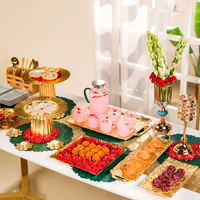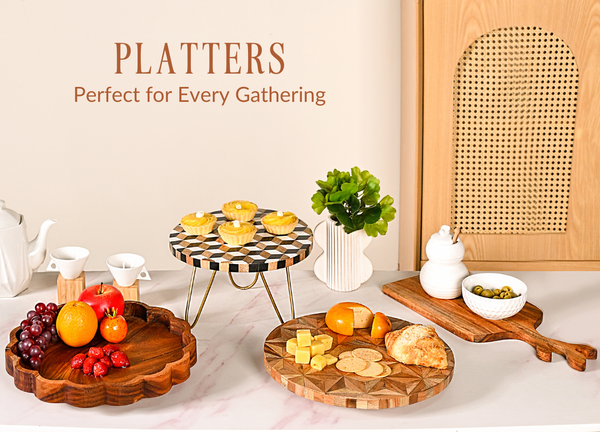Warning!! Terracotta is dangerous for cooking! Or… are they? Stay tuned to find out.
The term "terracotta", derived from the Latin word “tera cocta”, meaning “baked earth”, refers to a kind of earthenware that is formed from natural clay and fired at low temperatures. Terracotta has been utilised for centuries in different ways, ranging from art and architecture to household utensils. It is a classic and useful option even in contemporary households.
In culinary traditions, terracotta has a long history, especially in India, the Mediterranean region, and Africa. To talk about India, terracotta has been in use since the Indus Valley Civilisation. They displayed their artistic abilities by decorating certain pieces with geometric or animal themes, while others were simple. These containers were a type of utilitarian crockery since they were used to store, prepare, and serve food and water. This extensive usage of terracotta is a reflection of the civilisation's life and profound mastery of materials and craftsmanship.
Now that we know what terracotta is, let’s separate facts from fiction!
1. Terracotta crockery is unsafe for cooking: It is a common misconception that terracotta is dangerous for cooking. This mostly started making a buzz because some terracotta crockery is glazed with cadmium-based paints to create a shiny and bright finish. The presence of this chemical element in any kitchen utensil is a health hazard.
Given that, terracotta is entirely safe when made from natural clay without any additional substitutes as such. As already mentioned above, it has been used for generations after generations in some cultures, which justifies its non-toxic nature. All it needs to be is pure and perfectly glazed or unglazed.
2. Terracotta or earthenware can be smelly: Although it has an earthy scent of its own, terracotta does not hold an awful odour. It has a smell similar to petrichor. However, not everybody has a liking for such smells. Apart from that, it can get smelly if it does not get proper care and enough air or sun to dry after washing.
Since terracotta is naturally porous, oils and moisture can all be absorbed. It may retain odours from meals, particularly those that are spicy or greasy, if it is not well seasoned before use or cleaned after use. Unpleasant odours can result from mould or bacterial growth when moisture is trapped inside the pores and not allowed to dry fully.
However, all these are basically due to improper maintenance and can be avoided with proper care. Additionally, this can be solved by simply drying off the pot thoroughly or heating it up.
3. It is fragile and not durable: While it is more delicate than metal, good quality terracotta is sturdy and long-lasting when it is made of pure clay and is heated at comparatively lower temperatures of 900°C to 1000°C. Moreover, to ensure durability, some earthenware is fired up to 1100°C. In addition to that, the matte, earthy appearance frequently supports the notion that it is “delicate” and may result in cracks. A cold terracotta pot, for instance, may break if it is placed on a hot burner or moved from the oven to the refrigerator.
Again, these errors occur because some users might not have the full knowledge of its mechanisms and conclude that earthenware is unreliable. On the other hand, to keep terracotta crockery away from any damage, it is important to heat it seasonally. Many traditional households have used it for decades as a mark of their culture, as well as a healthy alternative. In short, maintaining its lifespan is just a question of technique!
4. Terracotta alters the taste of food: This myth specifically revolves around two important things. First, unfinished or faulty manufacture, and second, improper maintenance. Many people believe that the clay adds a strange or "muddy" taste, particularly when it's used in cooking. This impression is frequently based on experiences with terracotta that has been improperly crafted or mindlessly maintained. When it is washed and soaked in water, the pores tend to retain moisture if not dried completely. This leads to residual moisture odour, which can be mistaken for a change in the food's flavour.
On the other hand, terracotta increases flavour rather than diminishing it. Terracotta's porous structure makes it possible to cook food slowly and evenly, allowing ingredients to combine wonderfully and unleash their inherent flavours over time. In fact, it is praised by many chefs for the earthy aroma it adds, particularly to foods like Mexican beans, Moroccan tagines, and Indian dals. It enables a smooth, balanced cook, maintaining both nutrition and flavour, in contrast to metal pots that could heat unevenly or react with acidic substances.
5. Terracotta is unlabelled and cannot be trusted: In plain language, this perspective is a negative reflection of globalization and/or pop culture. It has changed the way we buy in the era of curated shopping carts, aesthetic hauls, and viral "what's in my kitchen" videos. Labels are becoming important, not only for luxury but also for establishing a social status. Anything without a label, from dinnerware to skincare products, is viewed with suspicion.
Therefore, these traditional earthenware have also faced the same. People tend to question the authenticity of the products that are made by local craftspeople. Customers are left in the dark since there is no proof of the materials used and whether they adhere to fundamental safety and health regulations.
This is a valid point as a whole. However, it should not be simply dismissed because it has no labels on it. A thorough knowledge and wise choice would lead you to amazing earthenware.
Well, if you want to buy terracotta crockery and don’t know where to buy from, check out our range of terracotta utensils and get started on your healthy living journey.
In conclusion, terracotta is one of the best alternatives for toxic plastics or any artificial cookware because it is solely made from and within the earth, which is why it is biodegradable and environmentally friendly. Moreover, as we all know that the world is changing rapidly, it is very important that we do not forget our roots and most importantly, that we take care of our health as well as the environment, and since education starts at home, using terracotta in our households would make each one of us a part of a bigger cause for humanity.
























